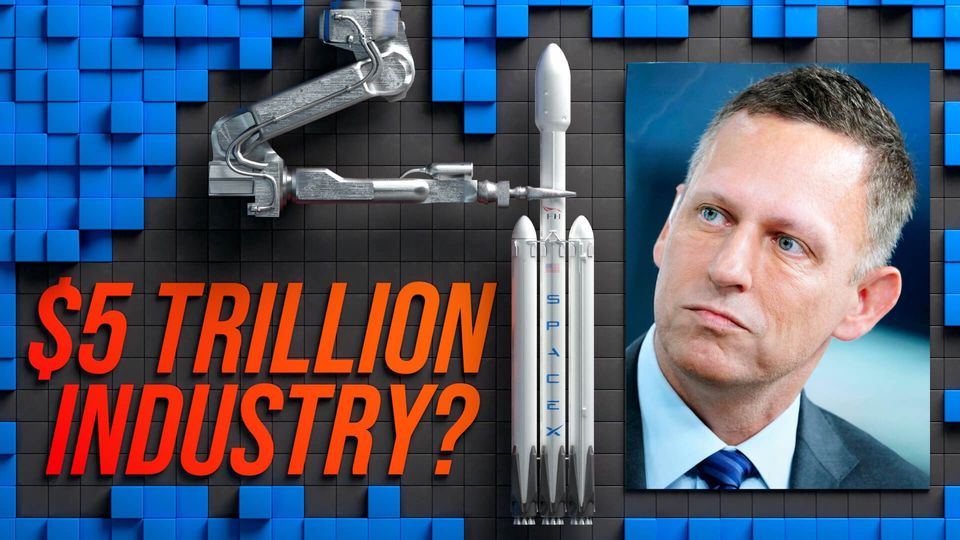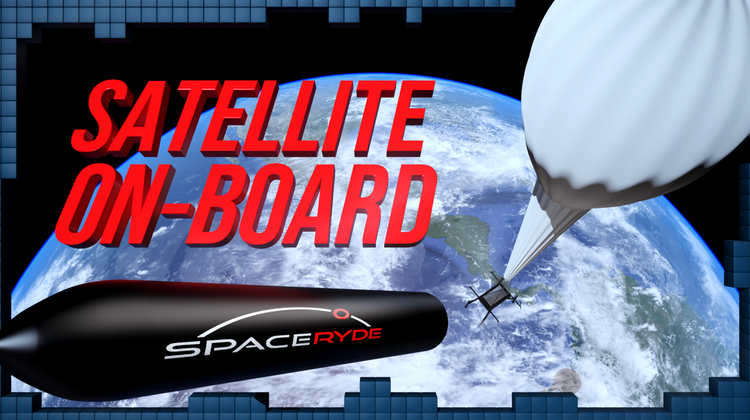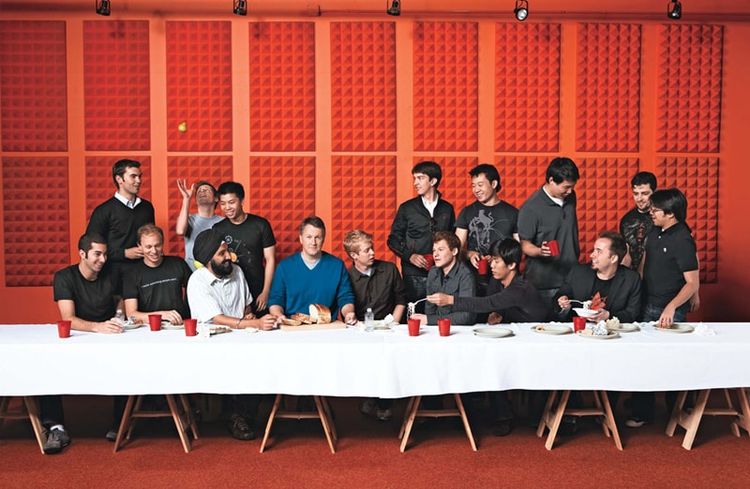Peter Thiel's Big Bet On Varda Space Industries

Peter Thiel is one of the most legendary investors in Silicon Valley. He’s helped build PayPal, Facebook, and Palantir into massive multi-billion dollar companies. And now he has his sights set on space manufacturing. And I’m not talking about making rockets here on earth; when I say “Space Manufacturing” I actually mean producing physical goods in low earth orbit and then bringing them back down to earth.
If that all sounds a little crazy, don’t worry, it was entirely new for me when I started researching this post. But, I’m going to walk you through the fascinating history of space manufacturing and then work through exactly how Thiel plans to make this a reality.
When you’re a multi-billionaire like Thiel, you don’t need to get your hands dirty with founding a company to attack an interesting problem anymore. Thiel has created a platform for building and scaling the most promising business ideas with Founders Fund, his $6 billion investment firm. And Founders Fund isn’t like most venture capital shops.
Most VCs focus on meeting entrepreneurs already running existing businesses and then giving them money to help grow what’s already working. They usually take a board seat and help set the high-level strategy, but it doesn’t go much deeper than that.
And Founders Fund does do a lot of deals that look exactly like that. But recently, they’ve been going a level deeper and co-founding companies alongside entrepreneurs. They did this with the defense technology company Anduril, where Trae Stephens, a partner at Founders Fund, stepped up to co-found the company alongside Palmer Luckey.
This model is typically called “an incubation” or “a venture studio company,” and there have been some massive successes. The cloud data storage company, Snowflake, was started this way by Sutter Hill Ventures and is now worth $80 billion. And this is the model that Thiel and Founders Fund are using to make space manufacturing a reality.
At the center of this project is Delian Asparouhov, a VC at Founders Fund and a cofounder of Varda Space Industries. He’d been tracking the trends in the aerospace industry for years and assembled a team to help build this new company. Varda’s name is a J.R.R. Tolkien reference, like the other Founders Fund incubations, Palantir and Anduril.
Who Is Varda’s Founder, Delian Asparouhov?
Delian has been speedrunning Silicon Valley for the past eight years. His resume has it all: TED Talk, MIT Dropout, Startup Founder, Y Combinator, and VC Investor.
And now he’s speedrunning the company-building process. Varda raised a $9 million seed round back in December of 2020, and they just closed a $42 million Series A in July of 2021. That’s a pretty insane amount of money to raise so quickly, but Delian has a unique strategy for capturing this new market that completely justifies a more aggressive fundraising timeline.
The typical path in Silicon Valley used to be: work at a big company for ten years, then work on a startup for the next ten, and then become a VC in your forties. But Delian is moving ridiculously quickly, which will be a big theme throughout this story. In fact, he is so obsessed with speed that he counts the exact number of days since Varda was founded.
Delian says,
This is the best way to institute an ethos because, at the end of the day, the thing that is always difficult about startups is early on - it’s easy to move super fast when you're like six people in a room. You all can communicate really easily, et cetera. Once you become 600, all of a sudden decisions start to slow down, and things start to slow down. - Delian Asparouhov
It’s easy to look at Delian’s insane level of energy and think he might be getting ahead of himself on this whole “manufacturing stuff in space” thing. But he’s been watching the industry closely for years. Space manufacturing dates back to the sixties, so let’s go through the history to see how we got here.
The History Of Space Manufacturing
Even though America won the Space Race and landed a man on the moon on July 20th, 1969, it was the Russians who were technically the first to manufacture something in space. During the Soyuz 6 mission, Russian cosmonauts welded aluminum, titanium, and stainless steel together using a hardware unit called Vulkan.
Four years later, the United States launched Skylab, a fully functional space station equipped with a materials processing facility to grow crystals, process alloys, and weld metals using an electron beam. NASA astronauts spent 32 man-hours on materials science and space manufacturing during the mission and made some significant contributions that would be rolled into future missions.
Ten years after the Skylab launch, NASA began using the Spacelab facility. Spacelab was a module carried aboard the Space Shuttle 26 different times and served as a short-duration research platform. It wouldn’t stay in space, but it accomplished some pretty incredible things while it was up there. Spacelab was an extremely large program that could be reconfigured for each mission, leading to a remarkably high throughput of experimentation. For example, NASA performed 73 separate experiments in materials science, astrophysics, and atmospheric research in just one mission. Here’s a picture of a mercuric iodide crystal that was grown on Spacelab 3. Pretty incredible.
Space Manufacturing Today
Fast forward to today, and essentially all space manufacturing takes place on the International Space Station. Most of the products made in space are designed to stay in space, which makes sense. Giving astronauts the ability to fabricate parts quickly while aboard the space station speeds up research and development, and there’s even a plan to 3D print food on the station eventually. But Delian has an entirely different vision for Varda.
He explains this vision, stating that,
The more commercial reason to start the company is actually that there is a whole wide array of products that could significantly improve quality of life for people here on Earth that can only be manufactured in microgravity. - Delian Asparouhov
Delian wants to bring everything that Varda makes in space back down to earth. If that sounds insanely expensive, that’s because it is. At least for now. Delian’s entire plan with Varda is to position the company to take advantage of the exponentially decreasing cost of space travel.
See, when it comes to making computer chips, we’ve been blessed by exponentially increasing capabilities for decades now. The number of transistors in a dense integrated circuit essentially doubles every two years. This is called Moore’s Law, and it explains why computers have been getting smaller, faster, and cheaper so consistently.
Something similar is happening with space travel right now. When the space shuttle was in operation, launching a single kilogram into space cost $54 thousand on average. SpaceX has reduced that cost to just under $3 thousand using their Falcon 9 rocket, and it’s only getting cheaper.
Every year, SpaceX is launching more and more rockets and dropping the cost of getting to space. This is critical to Delian’s plan for Varda and the main reason why he couldn’t pursue this idea sooner. Elon plans to bring the cost per kilo down to just $10 with Starship, and while that’s certainly an ambitious target, if he can even get close, the economics of space manufacturing will start to make a lot of sense.
What Are The Benefits Of Space Manufacturing?
But you’re probably asking yourself, what would you even make in space? We seem to be doing fine here on Earth, so what could possibly be worth all this effort. Well, there are a few good examples:
1. Human Organs:
Growing a replacement heart or kidney in space might sound a little weird to some people, but if you’re one of the one hundred thousand people waiting for an organ transplant, I’m pretty sure you won't care where it came from, as long as it works. And there’s a lot of evidence suggesting that growing organs in microgravity yields remarkable results since the cells won’t collapse under their own weight.
2. Semiconductor Film:
Semiconductor film could also benefit from low-earth-orbit production, with some studies estimating that quality could increase by 10 thousand percent. That’s a huge step up from what’s possible on earth, but that’s because semiconductor film not only benefits from the microgravity environment but also from the complete lack of dust in space. Tiny dust particles routinely reduce the effectiveness of semiconductors made here on earth, but that’s not a problem one thousand miles up.
3. Fiber Optic Cables:
We use fiber optic cables to move data around the globe every single day. There is a special kind of fiber-optic cable made from fluoride glass called ZBLAN that could have as little as one-tenth the signal loss of traditional optical fiber. The problem is that these ZBLAN fibers are extremely difficult to manufacture here on earth. And, again, it all comes down to gravity.
As the molten glass is stretched into ultrathin fibers, tiny crystals form, which can weaken signals. When you’re up in space, the microgravity environment suppresses the formation of these crystals so that the resulting cables can carry more data over longer distances.
Human tissue growth has been tested on the ISS, but it’s been impossible even to try fiber-optic production in space with current technology.
Delian says,
For example, in a lot of fiber optics, there’s a toxic chemical that you want to coat the fiber optic cable with that protects it at the end of the process. No f***ing way is NASA going to let you put that toxic chemical on the ISS. If that thing gets out, you’re potentially killing astronauts - Delian Asparouhov.
But Varda’s space factories will be completely autonomous. Everything Varda launches into space will be completely self-contained, meaning they can work on manufacturing problems without risking human lives.
How Will Varda Achieve Its Goals?
Okay, so we’ve established that the whole Varda project is only possible because scientists have been testing space manufacturing for decades, and SpaceX has dropped the cost of rocket launches so dramatically, but here’s where the technology gets especially interesting.
Varda won’t be building rockets, only payloads that sit on top of SpaceX rockets, but they still have to solve a few critical problems once everything is up there. So Delian and his team are focusing on building three different systems.
The first is the actual factory. This needs to be small enough and light enough to fit on a rocket while still holding all the raw materials for whatever they are making on that trip, but you can’t just shoot a box into space and hope that it stays up there and then lands where you can find it. So they are also building a satellite to accompany the factory into space and serve as a command and control module. Lastly, once the product is finished, you have to get it back down to earth, which is no easy task. Atmospheric reentry is a precarious maneuver and the most challenging part of getting anything from space home safely.
Varda is well aware of this difficulty,
We’re regulated by the FAA because we’re re-entering over airspace. If we miss the atmosphere even by three or four seconds, you're talking about rather than landing in the United States; you’re accidentally landing in Europe. - Delian Asparouhov
This illustrates how aggressive Delian’s plan is for Varda. There are a few other companies that are working on space manufacturing currently, but they mostly focus on developing the factory exclusively and then partner with NASA to get everything to the space station and back.
The scale of the reentry problem really can’t be understated. To stay in orbit, anything in space needs to be traveling incredibly fast. A commercial airliner typically flies at around 500 miles per hour, but the international space station is traveling at whopping 17 thousand miles per hour. The deceleration that occurs during reentry is extremely powerful, and anything Varda makes in space will have to make it through reentry without getting damaged in the process.
This part of the equation is so critical to Varda’s success that Delian even recruited a CEO with experience specifically in reentry.
Delian states,
I realized that for the CEO position, I wanted somebody that had been at SpaceX and specifically on Dragon in particular because we have a reentry problem that we're trying to solve, and the Dragon is basically the only commercial reentry vehicle that's ever been built. - Delian Asparouhov
Varda is clearly a moonshot type of company, but Delian is placing his bets very carefully. SpaceX is top-notch in terms of rockets, so no need to reengineer things there. But no one has figured out how to solve reentry at the industrial scale Varda aims for, not even NASA.
NASA is an amazing organization, but its budget is just $24 billion per year. For comparison, Walmart spends that much money every three weeks. While partnering with government research teams can work in some cases, it’s not ideal for scaling an entirely new industry. For Varda to be truly successful, they need to be launching dozens of factories to space every month.
This is no easy task,
With Varda the initial market that we’re going after if we were to eventually satisfy the entire market that we’re going after, we would have multiple of our reentry capsules coming down per day and we would be buying a SpaceX rocket every other day. - Delian Asparouhov
The Future Of The Space Manufacturing Industry
You might be asking yourself, how big of a market is space manufacturing anyway? Well, it’s currently a rounding error, but the global space industry is valued around $420 billion, and that’s growing rapidly. Last year alone, investors poured nearly $10 billion into space companies, each with slightly different approaches.
Companies like Hadrian and Relativity are developing products on Earth that are meant for space. And a company called “Made in Space” is, you guessed it, making things in space. But everything Made in Space produces is designed to stay in space, not reenter back to Earth. That’s where Varda is unique.
When it comes to the space industry’s growth, we see steady progress start to compound in all sorts of important metrics. The cost of launching a satellite is falling dramatically. The time between launches is getting shorter and shorter. And even the number of humans who have been to space is increasing faster than ever before.
When Jeff Bezos returned to Earth after his trip on Blue Origin’s New Shepard rocket, he had some poignant words about the importance of space manufacturing:
We need to take all heavy industry, all polluting industry, and move it into space. And keep Earth as this beautiful gem of a planet that it is. That's going to take decades to achieve, but you have to start. And big things start with small steps. - Jeff Bezos
So, can space manufacturing become a $7 trillion industry? That number sounds a bit ridiculous, but the global manufacturing industry does generate well over $7 trillion per year. And sure, we’re not going to move all of that to space anytime soon, but what about in a hundred years? And what could happen in a thousand?
Humanity will become multi-planetary, probably within our lifetime. When we begin seriously expanding our solar footprint, we’re going to have options as to where we choose to build things. We’ll be able to put certain things on Earth, other things on Mars, and we’ll have plenty of space in between, pun very much intended.
Some people find it difficult to get excited about things that will take years, if not decades, to bear fruit, but I, for one, am not one of those people. Big things have small beginnings and Varda is the first small step in an exciting direction.
If you want to chat about space manufacturing, DM me on Twitter or follow Delian (@zebulgar).
If you liked this post, please check out this video about Varda:




